You’ve built businesses. Some worked. Some tanked so hard the word “investor” still stings. Either way, you’ve got stories. And stories beat fake gurus every time.
Business coaching sits inside a booming market. The global coaching industry is projected to reach $7.30 billion in 2025, with the US contributing about $20 billion across coaching niches. Over 123,000 professionals already call themselves “coaches.” It’s crowded. Crowded means demand.
And people aren’t paying for pep talks. They’re paying for scars. For the coach who hired the wrong person, cried at 2 a.m., and still showed up to fix it. That’s the currency.
Becoming a business coach online isn’t about polishing an Insta-bio. It’s about knowing how to find coaching clients, using real business coach training, and running webinars people don’t bail on.
If you want to learn how to become a business coach, the real way, not the “buy my $99 course” way, keep reading.
Your 9-Step Blueprint on How to Become a Business Coach
Most blueprints feel like homework. This one keeps it simple: how to find coaching clients, build an online presence, and shape a practice that fits your style. From testing a business coach webinar to exploring e-commerce coaching or formal training, here’s a path that feels doable without the hype.
1. Pick Your Niche and Coaching Model
Trying to coach “everyone” is how you end up with no one. Niche down so clients know exactly what they’re buying.
How to Validate Your Niche:
1. List five problems you’ve actually solved
2. Test demand with Google Trends or Ahrefs (look for 1K+ searches/month)
3. Scan LinkedIn for under 500 specialists in that niche
4. Run five short validation calls: “What’s your biggest hurdle in [area]?”
Some Hot Lanes In 2026:
| Niche | Why It’s Growing | Ideal Client | Entry Price |
|---|---|---|---|
| AI For SMBs | 70% of small businesses lag on automation; AI spend up 40% year on year. | Founders at $500K - $2M revenue, weak on tech. | $4K rollout over 3 months. |
| Sustainable Scaling | ESG mandates rising; 55% of consumers prefer green. | Growth-stage ecommerce with eco goals. | $5K retainer for audits and strategy. |
| Remote Leadership | Hybrid work isn’t going away; 60% of managers untrained. | Leaders in tech or agencies. | $3.5K cohort program. |
| Sales Optimization | B2B close rates stuck at 20%; AI sales tools exploding. | SaaS heads hitting plateaus. | $6K funnel rebuilds. |
Pick the model that matches your edge. Specialists go deep; Reliable Retainers focus on steady monthly wins.
2. Define Your Ideal Client

Personas aren’t fluff; they’re your GPS. Build one that covers who they are, what they want, and what keeps them up at night.
Example Persona:
- Age: 30-45
- Revenue: ~$750K
- Psychographic: Ambitious but overwhelmed
- Pain point: Losing 30% of leads to bad funnels
Where to Get Real Data:
- Lurk Reddit’s r/smallbusiness
- Run LinkedIn polls in your niche
- Avoid “everyone”—that mistake cuts close rates in half
3. Develop Your Coaching Approach
Dictating doesn’t convert. Collaboration does.
The Winning Split:
- 60% discovery: Let clients talk through their challenges
- 40% structured expertise: Introduce frameworks and solutions
Tools to Use:
- Miro: For visual mapping and brainstorming
- Notion: For shared boards and documentation
Validation Test:
Run 2-3 beta sessions with peers. If 90%+ walk away with “aha” moments, you’ve nailed it.
4. Build Your Offer and Set Your Price
Hourly billing starves you. Price on outcomes.
Rule of thumb: If your coaching unlocks $100K in value, charge 10% of that.
Starter Package Structure:
- Duration: 12 weeks
- Price: $4K
- Includes: Calls, audits, playbook
Package Ladder:
| Package | What’s Included | Price | Target Result |
|---|---|---|---|
| Starter Intensive | 3 months, bi-weekly calls + audit | $3K–$5K | 20% revenue lift or 15% churn drop |
| Growth Retainer | 6 months, weekly syncs + workshop | $8K–$12K | Scaled operations, hire-ready systems |
| Elite Cohort | 4 months, group + 1:1 coaching | $6K/person | 50% average goal achievement |
| Sales Optimization | B2B close rates stuck at 20%; AI sales tools exploding. | SaaS heads hitting plateaus. | $6K funnel rebuilds. |
5. Get Your First Clients From Your Network
Don’t start cold. Start close. Launch a “Three for Free” offer: coach three clients for four weeks in exchange for testimonials and referrals. Aim for 30% to roll into paid.
Your Outreach Script:
“Hey [Name], I caught your post on ad fatigue. It’s a tough spot! I’ve boosted ROAS 25% for DTC brands like [Client]. Free 20-min audit to spot leaks?”
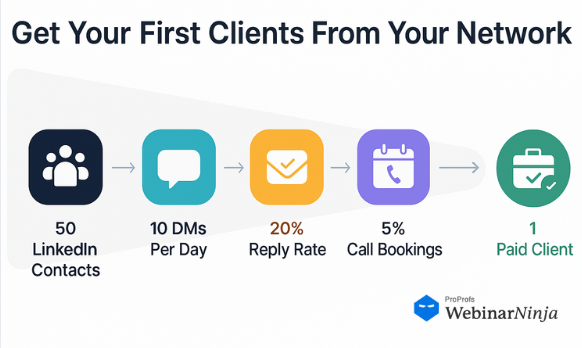
How to Do It:
1. Mine your network: Pull 50 LinkedIn contacts using the “Connections” filter, and prioritize your niche
2. Send 10 DMs/day, 5 days/week: Keep it short, specific, pain-focused
3. Launch “Three for Free”: Deliver 2 calls, 1 audit, 1 action plan per client
4. Follow up after 3 days: “Hey [Name], circling back. Still battling those ad costs?” (Cap at 2 follow-ups)
Tools You Need:
- HubSpot (free CRM)
- Calendly
Benchmarks:
- Reply rate: 20%
- Call bookings: 5%
- Goal: 3-5 consults in 2 weeks, 1 paid client in 30 days
Pitfall to avoid: Don’t blast generic messages. 60% of prospects ghost copy-paste pitches.
6. Phase Complex Projects
Big, undefined projects scare clients off. Break them into phases so you get paid early, build trust, and prove value fast.
Three-Phase Model:
| Phase | What You Do | Deliverable | Price & Duration | Why It Works |
|---|---|---|---|---|
| Diagnostic Audit | Interview team, analyze churn, review data | Five-page report with 3–5 quick fixes | $1.5K, 10 days | Low-commitment entry builds trust |
| Build-Out | Implement fixes (new funnel, CRM training) | Custom playbook + 2 workshops | $5K, 6 weeks | Tangible results cement value |
| Tune & Handoff | Optimize and hand over tools (KPI dashboard, SOPs) | Metrics tracker + handoff call | $3K, 4 weeks | Ensures client independence |
Your Pitch Script:
“Let’s start with a $1.5K audit to map your leaks. Then we build.”
How to Deliver:
1. Present in a 30-minute call with a one-page Canva proposal
2. Use Google Sheets for analysis, Miro for mapping
3. Send Loom videos for quick updates
4. Track tasks in a project management tool
5. Send weekly progress notes
Benchmark: 80% of clients should advance to Phase 2. Aim for $9.5K total per project.
Pitfall: Never underprice Phase 1. Charging filters serious clients.
7. Build Your Website and Brand
Your website is often the first place clients judge your credibility. Keep it clean, clear, and professional, not overloaded with fluff. Testimonials are your proof, but wait until you have at least two or three solid ones from Step 5 before building.
How to build it:
- Platform: For no-code ease, use Squarespace ($16/month) or Carrd ($19/year). Pick a clean template (e.g., Squarespace’s “Flatiron” for bold visuals).
- Must-have pages:
- Hero Section: One killer line with proof: “Scaled SaaS from $500K to $2M in 9 Months.” Add a headshot and CTA (“Book a Free Audit”).
- Services: List 2–3 packages (e.g., “3-Month Revenue Sprint: $4K”). Include 1-sentence outcomes: “Cut churn by 20%.”
- Case Studies: Showcase 2–3 wins (e.g., “Helped DTC Brand Boost ROAS 30%”). Use a quote + 100-word story per case.
- Lead Magnet: Offer a freebie like “5 AI Hacks for E-com Growth” (PDF via Canva). Link to a Google Form for email capture.
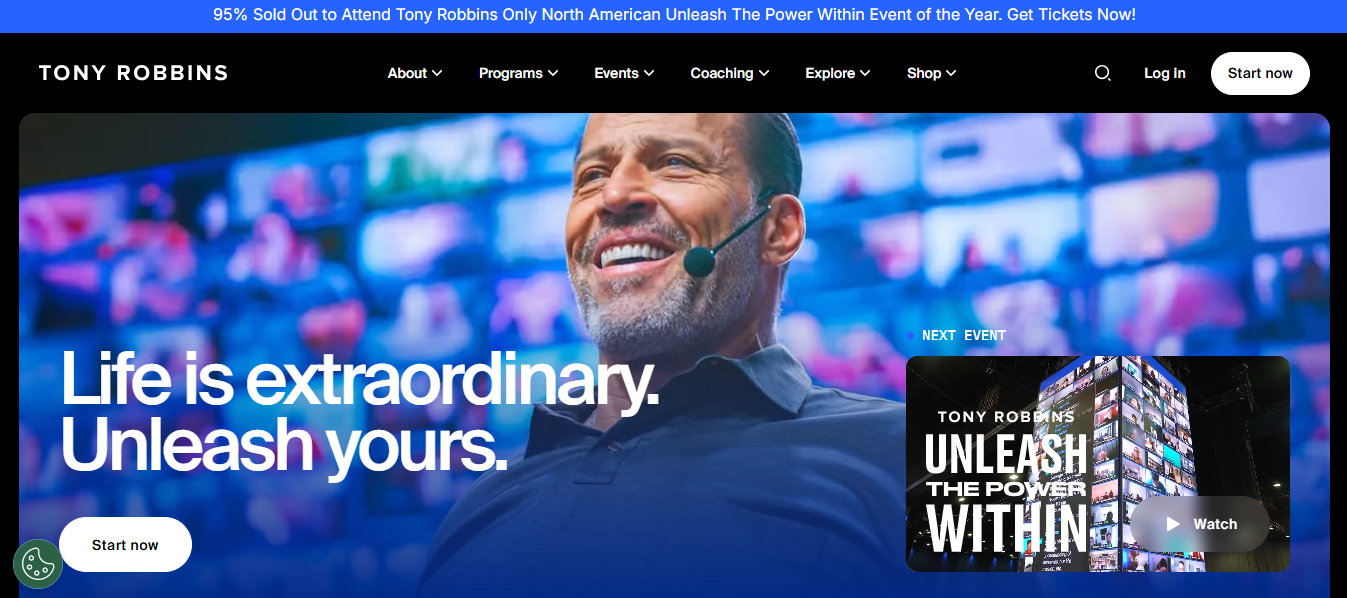
Source: Official Website of Tony Robbins, Life & Business Coach
- SEO juice: Optimize for niche keywords (e.g., “AI coaching for ecommerce” or “SaaS growth coach”). Use Yoast (free plugin) to hit 80+ SEO scores.
- Branding vibe: Bold colors (navy + neon green), sans-serif fonts (e.g., Poppins). Tagline: “From Stuck to Stacked—Your Growth, Unlocked.” Keep it punchy, not corporate.
- Content tie-in: Add a webinar signup (e.g., “Join my free Scaling 101 webinar”). Use WebinarNinja to host and automate replays, turning site visitors into leads without extra work.
Execution plan:
- Week 1: Collect 2–3 testimonials (video or text) from free clients.
- Week 2: Build site (4 hours max). Test on mobile—50% of visitors browse there.
- Week 3: Launch lead magnet and webinar signup. Drive traffic via LinkedIn posts linking to your site.
8. Create Content That Pulls Clients
You can’t sit back and hope clients find you. Content is the loudest proof that you know what you’re doing.
Platform Strategy:
LinkedIn (for SaaS founders):
- Publish weekly 500-word posts
- Topics: “Fixing SaaS churn in 3 steps” or “Why your ad spend is bleeding 30%”
YouTube (for E-com owners)
- Post 8-10 minute breakdowns
- Examples: “Build a remote team playbook in 5 moves” or “3 AI hacks that save SMBs hours”
Lead magnet to offer:
- “10-Point AI-Integration Checklist”
- Exchange for emails
Webinar strategy:
Record once with WebinarNinja, automate replays, and keep capturing leads while you coach.
Here’s an interesting case study for you:
Case Study: Turning Webinars Into a Coaching Growth Engine
Network marketing coach Michael Lancto hit a wall with clunky, expensive platforms like Zoom. Switching to WebinarNinja gave him live Q&A, chat, and recording tools that made his sessions feel personal while cutting costs.
9. Market and Scale
You cap out fast alone. Growth means systems.
Scaling Tactics:
- Podcast guest spots: Reach established audiences
- LinkedIn ads: Test with $300 budget
- Strategic partnerships: CPAs or consultants who serve your audience
- Group cohorts: $997 programs for scalable revenue
Webinar Automation:
Run a live masterclass once with a tool like WebinarNinja, then put it on repeat to convert 15 – 20% of viewers without grinding every week. Automating a business coach webinar is one of the simplest ways to keep finding new coaching clients while scaling an online business coaching practice.
Learn How to Create a Sales Funnel for Coaching and Training:
Business Coach vs Consultant: What’s the Real Deal?
Forget the labels for a second. A business coach isn’t a consultant handing you a PDF and walking away, and they’re not a mentor dropping casual advice over coffee. A coach blends the two. You dig into pain points (“Why’s your churn at 25%?”), introduce real frameworks (like a revenue funnel audit), and stick around while the client learns to run it themselves.
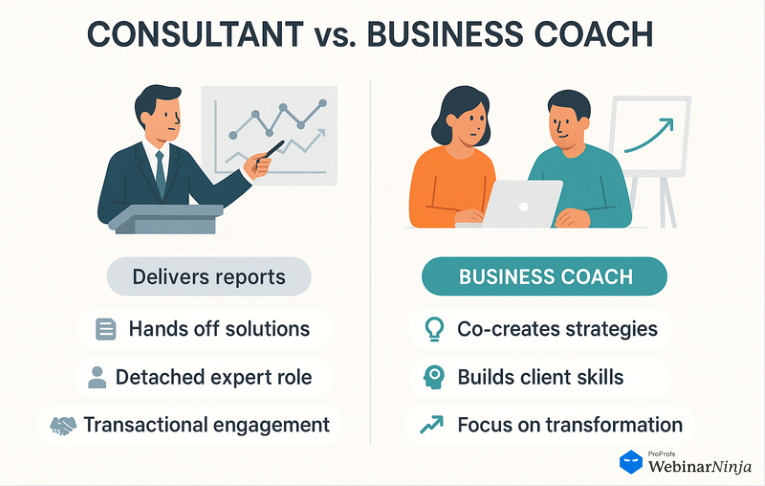
And it works. The International Coaching Federation found that 80% of clients walk away more confident, and 70% hit stronger performance metrics. This is not theory; it’s proof.
Different coaching styles fit different people:
- Head coach: The strategist who connects the dots across sales, ops, and culture. Think quarterback during a startup pivot.
- Specialist coach: The niche expert, like an ecommerce business coaching pro focused on SEO or funnels, or someone running a business coach webinar to train teams in real time.
- Solo coach: The all-rounder, handling big-picture and tactics for lean founders and freelancers trying to grow an online business.
At the core, business coaching is about empowerment, not enablement. Teach clients to navigate their own challenges, and they’ll keep coming back for your guidance. That loyalty fuels steady growth, whether you’re looking to become a business coach online or deepen your practice through formal business coach training.
Business Coach Archetypes: Which One Fits You?
Not every business coach looks the same. Some play the strategist, some live in the weeds, some are the ones clients call when the ship’s already sinking. Pretending there’s one “ideal coach” is how you end up sounding like every other LinkedIn bio out there.
Archetypes aren’t rules. They’re mirrors. They show you how you naturally work with clients, and why certain people will click with you while others never will.
There are a dozen ways to play coach, but only eight really matter. Spot the one that feels like you and own it. If you’re working to become a business coach online, knowing your archetype makes it easier to position yourself and attract the right clients. It also helps you see if your path leans toward ecommerce business coaching, group programs, or 1:1 work.
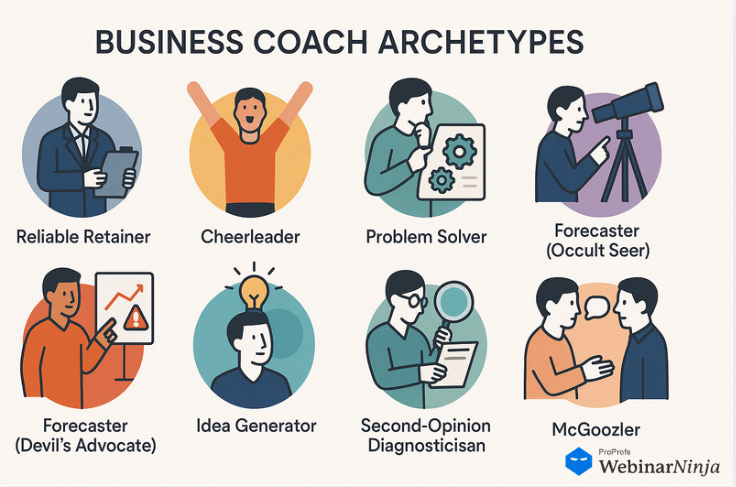
| Archetype | What You Do | Best Client Fit | One Move to Start | |
|---|---|---|---|---|
| Reliable Retainer | Steady tweaks, like monthly KPI tune-ups. | SaaS or retail needing consistent growth. | Offer $2K/month for 4 check-ins + 1 audit. | |
| Cheerleader | Spark motivation, drive accountability. | Burned-out agencies or sales teams. | Assign one weekly action via Trello. | |
| Problem Solver | Fix specific pains using 5 Whys to dig deep. | Stalled launches or broken funnels. | Map issue in 2-hour session, propose 3 fixes. | |
| Forecaster (Occult Seer) | Predict trends with gut + pattern recognition. | Fintech or retail facing market shifts. | Run 90-min trend workshop, charge $1.5K. | |
| Forecaster (Devil’s Advocate) | Stress-test plans with risk scenarios. | Startups pre-pivot or investment. | Deliver 5-risk report for $2K. | |
| Idea Generator | Brainstorm bold plays, like new revenue streams. | E-com or startups eyeing diversification. | Lead 90-min idea sprint, prototype 1 idea. | |
| Second-Opinion Diagnostician | Audit big decisions for blind spots. | Pre-merger or hiring execs. | Write a 5-point audit report, charge $2.5K. | |
| McGoozler | Nudge clients to “aha” moments subtly. | Ego-driven founders needing gentle shifts. | Mirror their language in calls for buy-in. |
How To Pick Your Business Coach Archetype
1. Review your track record: Write down the moments where you delivered real wins.
2. Spot the pattern: If you fixed messy operations, you fit the Problem Solver archetype. If you energized teams, you’re more of a Cheerleader.
3. Test it out: Conduct a 30-minute mock session with a peer on your top two archetypes and ask for feedback.
4. Focus: Stick to one or two archetypes in the beginning.
5. Expand later: Blend additional styles once your core is solid.
Do You Need Business Coach Training?
Business coaching isn’t regulated, which is why $10K “certifications” are everywhere. Skip them. If you want structure, choose an ICF-accredited program in the $1K – $2K range. The value is in live practice and role-plays, not the badge. Training may boost credibility by 25%, but three strong testimonials will beat any certificate. No case studies yet? Offer to coach a local startup or work as a business coach for online business owners in exchange for a video review.
Mastering The Craft Of Business Coaching: Communication and Ethics
Starting is easy. Mastering is where most coaches trip. Over half admit they struggle with trust, and nearly two-thirds of clients stay only if results are measurable. Coaching isn’t pep talks. It’s clean project management, clear communication, and a hard line on ethics. If you want to become a business coach online, sharpening these skills is what separates long-term success from short-lived hype.
Project Management Matters
You’re balancing two projects at once: your client’s goals and your own operations. Drop either and you’ll lose momentum fast. For the client, your job is simple: deliver outcomes they can see, like 20% lower churn or 15% higher ROI. For your business, it’s making sure you’re tracking hours, following up, and not burning yourself out.
Keep it simple: use any project management tool or playbooks from business coach training to track goals, tasks in progress, and wins. Share it with clients so they see the progress as it happens, and reuse the same view in your How to find coaching clients outreach. Internally, review your workload weekly and cap your hours so you’re not giving away time. And don’t let projects balloon out of control. Set revision limits early and stick to them.
The #1 Rule: Don’t Surprise the Client
Nothing erodes trust faster than blindsiding a client. Transparency beats polish every time. If a campaign tanks or a rollout stalls, flag it quickly and frame it with a solution.
Twice-Monthly Updates:
- Wins achieved
- Risks identified
- Next steps planned
When Things Go Wrong:
Lead with fixes, not excuses:
“Your funnel is leaking at checkout; let’s test two alternatives this week.”
Monthly Alignment Calls:
Make sure you’re still on the same page. Problems handled openly build loyalty instead of doubt.
Start With A Solid Proposal
Vague proposals kill coaching deals before they start. Ambiguous language leads to misunderstandings, disputes, and clients having different expectations from what you intend to deliver. A clear proposal is your best insurance policy.
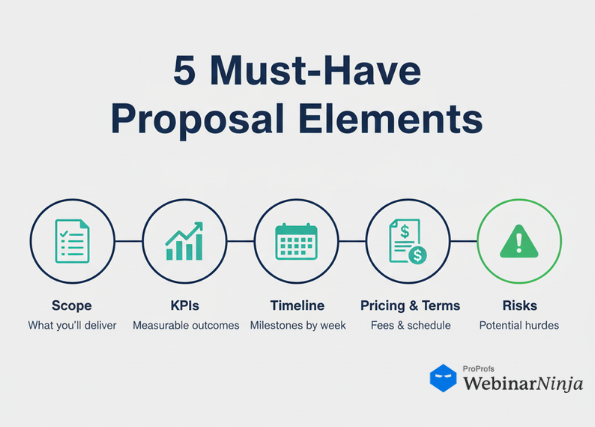
Cover the Five Basics:
- Scope: what you’ll deliver (example: “8-week funnel rebuild, 3 calls, 1 audit”).
- KPIs: the metrics that matter (“15% conversion lift” or “$50K revenue bump”).
- Timeline: milestones by week.
- Pricing and Terms: fees, payment schedule, and exit clauses.
- Risks: the hurdles that might get in the way.
Walk through it live with the actual decision-maker. And add a “success criteria” section so both sides agree upfront on what “done” means. It prevents half the disputes you’d otherwise face.
Ethics Are Non-Negotiable
In a coaching world drowning in hype and half-baked gurus, ethics are your unbreakable edge.
Clients smell the cash grab a mile away; they’re smart, have been burned before, and are hunting for real pros who won’t waste their time or wallet. Get crystal clear on your boundaries upfront, or watch them ghost you for the next shiny promise. Solid ethics will do more for your reputation than any business coach webinar or marketing push ever could.
Three Questions to Ask Yourself:
| Ethical Question | Why It Matters | How To Handle It |
|---|---|---|
| Do I know the role my client wants me to play? | Misaligned roles sink a quarter of engagements. | Ask directly before kickoff and document it. |
| What if my advice makes someone look bad? | Exposing weak spots can create drama. | Frame feedback as team improvement, not personal blame. |
| How far should I push back? | Too soft and you’re irrelevant, too hard and you’re toxic. | Challenge most bad calls with data; walk away if values clash. |
When to use this checklist:
- Before you sign a client
- Mid-engagement review
If someone asks you to cross a line:
Walk away with your reputation intact:
“I’m not the right fit for this approach, but I can recommend someone who is.”
That one sentence protects your integrity and keeps the door open for referrals.
The Real Test Of A Business Coach
At the end of the day, results are the only scoreboard that matters. Did the team win the game? Did the founder finally see progress? Did the numbers move in the right direction? That’s the real test of a coach.
Thread it together: your edge + archetypes + this roadmap = a $100K+ practice. The demand is there; business coaching for online business is part of a $20 billion market in the US, but opportunities without execution are wasted.
Start small. Pick the archetype that feels like second nature, design a clear offer, and test it with a few clients. Collect testimonials, refine, and keep building. Scale comes from systems, not chaos. WebinarNinja make it simple to run a business coach webinar once and keep it generating leads in the background, turning one strong session into a steady flow of clients while you focus on coaching.
This isn’t about hype. It’s about showing up, delivering wins, and building a practice that lasts.
Frequently Asked Questions
How do I structure and prepare for my first coaching session?
Run 45–60 minutes: open with a quick win, clarify goals, set 2–3 actions, and close with feedback. Share a short agenda ahead of time; 80% of clients value structured sessions. Recording for self-review is fine if you delete it afterward with permission. Running a short business coach webinar is also a safe way to practice your flow before live client sessions.
What are the key legal and financial setup steps for a new coaching business?
Start as a sole proprietor, then form an LLC once revenue passes $10K. Track income with tools like Wave or QuickBooks, save 25–30% for taxes, and get liability insurance ($200–$500/year). Free SCORE mentors can help with local rules. If your focus is on business coaching for an online business, also check platform compliance around payments and digital contracts.
How do I measure long-term success in my coaching business?
Revenue is one marker, but retention and impact matter more. Aim for 70%+ client retention and track client outcomes like 20% average revenue growth. If 80% of clients hit their goals, your model works. Below 60%, it’s time to adjust. These metrics also help when you’re learning how to find coaching clients who stay for the long haul.
What if a client isn’t progressing? How do I address it without losing them?
Check by month two, run a reset session, and clear barriers. Seventy percent of stalled clients recover this way. If not, suggest a pause or referral. Document progress and offer a capped guarantee (up to 50%) to build trust without draining your time. This approach is vital if you want to become a business coach online and maintain credibility across a wider client base.
Want to host a webinar for free?
Use WebinarNinja to teach, improve marketing, and grow your sales.






